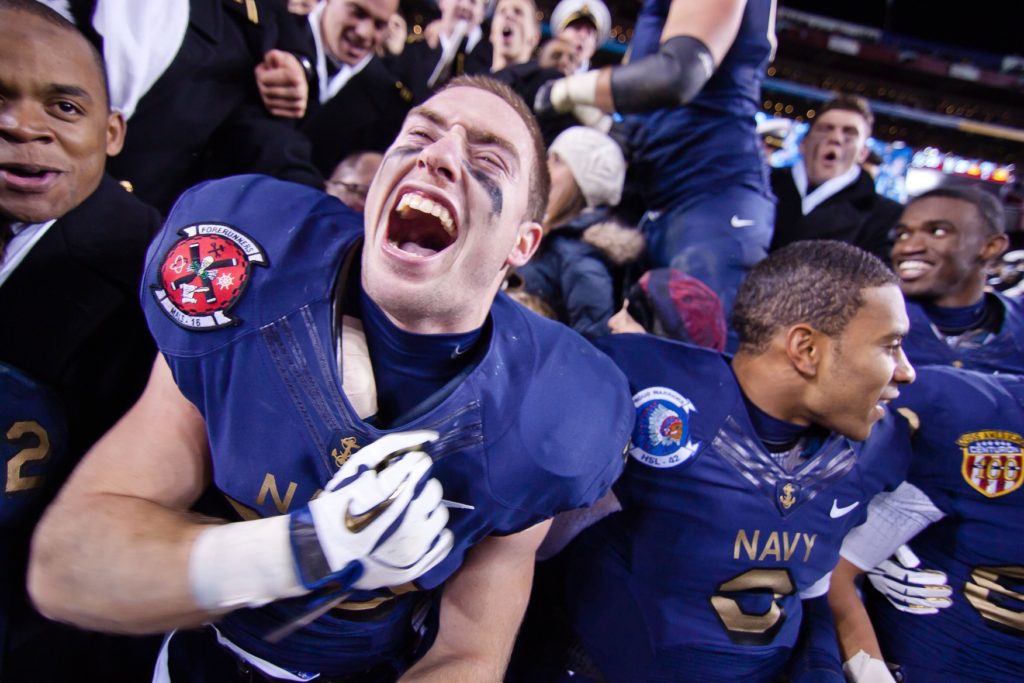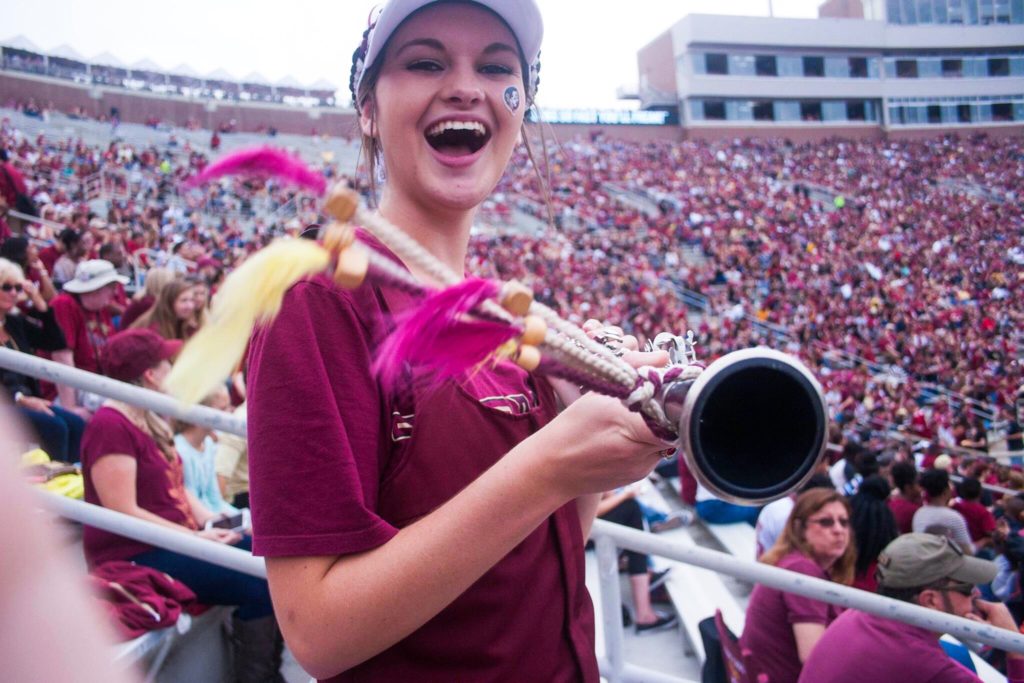The American College Football Playoffs are almost here, and you know what that means. People talking to you (or around you) about a sport that you don’t know (and don’t care) anything much about. Some of those people might even be important to you: like maybe your boss, your secret crush, your next-door-neighbor, your spouse, your in-laws, or the person sitting next to you on a really long plane ride. Should you find yourself in that situation, fear not. You just need to learn a new language: you need to learn how to talk sports. And we got you.
Why bother investing time in learning about such a trivial matter as college football, you say? Because one of the core bonding rituals in many workplaces, board meetings, gyms, bars, New Year’s Eve parties, backyard barbecues, car pools, coffee shops and holiday dinner tables is a group discussion of professional sports. And most of it is not intuitive to even the biggest brains in the room. For example, sports talk is seasonal, but not in the way a non-sports aficionado might imagine. In America in August, for example, you would think that baseball would be the topic, since the MLB season is in full swing at that point. But you’d be wrong: in most US offices, the topic in August is either the US Open tennis matches, or the upcoming NFL season.
You see? It’s a puzzle for many of us.
Right now, one of the topics de jour is college football. The playoffs are about a week away, and many people are going to be spending New Year’s Day immersed in them. So whether you’re going to be curled up on the couch beside such a person, or showing up for work on January 2nd in an office full of such people, you need to get smart if you want to keep up with the chatter.
You could of course choose to opt out of the conversation, and try to change the subject to what Mariah Carey was wearing on New Year’s Rockin’ Eve, and whether or not she was lip-syncing, but you would do so at your peril. Genuine personal connections are crucial to your success, not to mention your happiness. Someday, Sports People will challenge themselves to learn how to talk fashion and pop music – but until that happy day arrives, we Non-Sports People must develop some coping skills if we hope to establish meaningful connections with the other tribe.
Of course one could try to fake it by saying things like “How about that Crimson Tide?” “Can you believe those Sooners?” Or “Ohio State was robbed!” These would be appropriate comments that will definitely spark a conversation. The problem is, you won’t be able to hold up your end of the discussion after your initial volley.

So here at Dandelion Chandelier, we’re going back to basics to cover the bare minimum you need to know in order to be able to participate in a conversation without embarrassing yourself or annoying anyone. We’ve provided crash courses in baseball, hockey, and pro football for those with only a passing interest (or no interest at all). Now it’s time for college football, and our Head of Research is breaking it all down for us (thanks, girl!)
Here are the basic facts: The regular college football season runs from the last week of August until the first week of December, and each team plays 10-13 games. Regular-season games are played on Friday night and on Saturday, both day and night. The postseason runs from late December into early January. In 2014, the College Football Playoffs (CFP) were established to determine the single best college team in the country, a shift from the previous focus on regional rivalries.
There are still lots of postseason Bowl Games, some more consequential than others. The only two that casual fans need to know about this year are the Rose Bowl and the Sugar Bowl, both played on New Year’s Day, as those are the only ones that matter for the CFP.
At the end of the regular season, the CFP Selection Committee – which has 13 members – invites four teams into the playoffs. The four teams chosen this year are the Alabama Crimson Tide and the defending champion Clemson Tigers (who will play in the Sugar Bowl); and the Oklahoma Sooners and the Georgia Bulldogs (who will meet in the Rose Bowl).
Heading into the Bowl Games, each team is ranked (or “seeded”) – this year, the top-ranked team is Clemson, followed by Oklahoma, Georgia and Alabama. The No. 1 seeded team plays the No. 4 seeded team in one Bowl game, and the No. 2 and No. 3 seeded teams face off at another. There are six Bowl Games that rotate as hosts of the semi-finals. They’re called the “New Year’s Six:” The Rose, Sugar, Peach, Orange, Fiesta and Cotton. These are six of the 10 oldest bowl games in the country.
The final game of the season is the CFP National Championship – it’s on January 8th. The location moves every year (just like the Super Bowl) – this season, it’s in Atlanta. The highest annual honor for an individual player is the Heisman Trophy. This year’s winner was Oklahoma quarterback Baker Mayfield. (Fun fact: because the statue atop the Heisman Trophy is a player with his arm extended to keep others away from the ball, a person who’s highly territorial or who refuses to share information with others at the office is sometimes described by Sports People in upper management as “giving people the Heisman.” This is not a good thing.)
Repeat these essential facts until you feel able to recite them without consulting your notes, even after your first beer.
Good news! You’re already 80% of the way there. Toss off a couple of casual comments that cleverly alert your audience that you have this data at your fingertips, and you’ll earn the right to stay in the conversation.

To get all the way to full preparedness, here are the 5 other facts that one could reasonably be expected to know as a layperson:
1. Must know: The NCAA (National Collegiate Athletic Association) Division I is the most elite group of college football teams. Those are the match-ups most people will be talking about all season long. Nice to Know: One of the most confusing elements of college football is all the conference names you’ll hear being tossed around. Under Division I is a subdivision called the Football Bowl Subdivision (FSB) and underneath that are 10 regional conferences that include 130 schools. The only ones you should ever need to know by name are “the Power 5:” the Southeastern Conference (SEC), the Big 10 (actually, 14 Midwestern schools), the Pac 12 (West Coast schools); the Atlantic Coast Conference (ACC) and the Big 12 (actually, 10 teams located in Iowa, Kansas, Oklahoma, Texas, and West Virginia). Extra credit: Notre Dame is one of the few schools that remain independent of any conference affiliation for football.
2. Must know: College athletes are not paid, but colleges are allowed to provide players with non-monetary compensation such as athletic scholarships that provide for tuition, housing, and books. Nice to know: There is an annual team limit of 85 players who can be receiving athletic scholarships (total team rosters are usually about 110 players). Extra credit: NCAA basketball was rocked by a bribery scandal earlier this year — coaches were being bribed by athletic shoe companies to steer their players toward affiliations with their brands in exchange for funding for their programs. One prominent coach was fired in disgrace. So far, no similar behavior has emerged in NCAA football.
3. Must know: There are numerous Bowl Games played in the postseason that have slightly odd names and no discernible purpose. Nice to know: Among these, our favorites are the Gasparilla Bowl, the Famous Idaho Potato Bowl, the Quick Lane Bowl and the Taxslayer Bowl. These are all actual games and names. Check if you don’t believe us. Extra credit: Each of these games is televised. Seriously.
4. Must Know: Other than Bowl Game speculation, the other story line in college football this week is Early Signing Period, which was allowed in college football for the first time this week. High school football players in the Class of 2018 were permitted to sign their “National Letter of Intent” months earlier than in the past. Instead of waiting until the traditional’ National Signing Day – the first Wednesday in February – players were given a three-day window from December 20 to 22 to lock in their spots in the recruiting class. Nice to know: In the past, only junior college prospects could sign up this early. Student athletes don’t have to sign early, but they can choose do so instead of waiting. The advantage for both sides is faster clarity about plans and options for the 2018 season. Extra Credit: The sports press is highly impressed with head Georgia coach Kirby Smart. He has finished this early recruiting cycle with the country’s highest-ranked class (followed by Ohio State), and is being hailed as one of the three or four best recruiting leaders at the college level right now.
5. Must know: If it feels as if college football games are on every channel, that’s because they are. The television broadcast rights to all six CFP bowls and the National Championship are owned by ESPN through at least the 2025 season. But national television rights for regular-season college football games are spread across ABC, ESPN, Fox (Big 10), NBC (Notre Dame) and CBS (best SEC game of the week). Nice to know: Games are available on the WatchESPN and Fox Sports GO streaming services, and also on Sling TV and PlayStation Vue. Extra credit: College football games are broadcast on select local terrestrial radio stations, and on ESPN Radio on mobile.

Most people root for their alma mater, if they happen to have attended an FSB school. If you’re not an alum of one of those colleges, just pick a team and join the fun (we were raised to root for the University of Michigan Wolverines). Following one team all the way through the season is the best way to stay up to speed on what’s happening – and there’s always the slight chance that you might actually start to enjoy it. You’ve been warned.
One last bit of advice? If you want to be totally up to speed every week, read TWIST – This Week in Sports Talk. We publish it every Sunday, and it has the three – and only three – things you need to know in order to talk sports like a champion all week long. Read it every week, and we promise you’ll never drop the ball.







